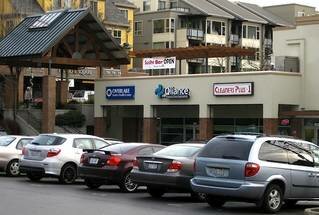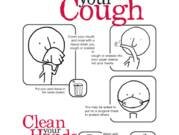Backscatter scan, courtesy TSA, leaves little about how it's hanging to the imagination.
Goldy at HorsesAss is having none of the full-body security scans starting up at SeaTac this September, claiming the invasion of privacy and safety concerns are just too much. (In March 2010, the TSA purchased 450 advanced imaging technology units with ARRA funds--at $130,000 to $170,000 each, says the Seattle Times.)
Regular surveillance cameras were enough to catch the TSA supervisor who stole $20,000 worth of valuables from checked luggage, but SeaTac, which has one of the more complex and inane security/performance art installations in the nation, has no problem with an invasive upgrade. (In fairness, they arbitrarily downgrade, too: "TSA Relaxes Restrictions for Cigarette Lighters and Breast Milk in Carry-On Luggage.")
Of the two types of imaging technology, millimeter wave and backscatter, it's the latter that has health professionals worried. Backscatter relies on low-dose x-rays just strong enough to "see through" clothes, but be reflected back by skin and soft tissue.
Health professionals are concerned that this kind of exposure directed at the skin could still have effects: "[T]here really is no threshold of low dose being OK. Any dose of X-rays produces some potential risk," David Agard, a biochemist and biophysicist at UCSF told NPR.
In an Orwellian touch of "sensitivity," the x-ray units employ a blurring algorithm while passengers are observed nude, and the TSA has instituted a complicated privacy procedure so that you will never actually see the officer checking you out nude:...
 Madison Park's beach is a prime source of Seattle's vitamin D intake.
Madison Park's beach is a prime source of Seattle's vitamin D intake.
Good news from the New York Times: "Given appropriate sun exposure in summer, it is possible to meet the body's yearlong need for vitamin D." Didn't know you could store up the D like a battery, did you? (Fun fact: it's actually a steroid hormone, not a true vitamin--if you get enough sun you don't need another source.)
The consulting physician on the article, Boston U's Dr. Michael Holick, suggests you take sun breaks "from 10 a.m. to 3 p.m. two or three times a week for 5 to 10 minutes." Put sunscreen only on your face, and--think Lady Gaga--maximize your skin exposure.
What's the big idea? Nutritionists have discovered that we aren't getting nearly the amount of vitamin D that we need. While a serious vitamin D deficiency has long been known to cause rickets, it's becoming more evident that chronic low levels of vitamin D can have serious health impacts as well.
Besides documented effects on bone health, Holick references studies that show a lack of vitamin D impacting multiple sclerosis, arthritis, type I diabetes, and immune response in general. Locally, the Fred Hutchinson Cancer Research Center has been researching vitamin D intake and colorectal cancer and breast cancer rates, and have also found that diet, geography, and lifestyle aren't good predictors of individual vitamin D levels; a blood test is the best way to be sure.
Here's the FHCRC line on vitamin D, what it does, how much you need, and how to get it....
Virginia Mason says more than 350 men stopped in for a free prostate exam last year, so they're doing it again, with a visit to Seattle and Issaquah next week.
More than 55 million American men are at risk for prostate cancer, and early detection is key. That’s why Virginia Mason Medical Center, in partnership with ZERO: The Project to End Prostate Cancer and KOMO 4, will host the only mobile, free prostate cancer testing program Thursday, July 29, in Seattle and Friday, July 30, in Issaquah from 9 a.m. to 5 p.m.
In Seattle, look for the mobile unit near the intersection of Ninth Avenue and Seneca Street in front of the Benaroya Research Institute at Virginia Mason. In Issaquah, it'll be in the parking lot at 100 N.E. Gilman Blvd., at the Virginia Mason Issaquah clinic.
You're assured that the drop-in screening is free and confidential. Volunteers will explain the screening process (a PSA blood test and an optional physical exam: see above video) and answer any questions, while Virginia Mason providers will perform the screening. ...
Our Flickr pool's +Russ caught this Ave Rat just before it will need to hit the toilet.
As regular readers know, The SunBreak has a proud tradition of sensationalizing rodent-related news.
However, there's nothing sensationalized in our reporting on the skyrocketing cases of rats in even the richest Seattle toilets. (Except where we invite you to imagine a pair a tiny rat jaws locked on your buttocks, later in this piece--to our knowledge, no one's nether parts have been nipped.)
The Great Recession has been a boon to toilet-dwelling rats, it seems. The number of complaints--from people staring back at beady little eyes in their toilet--increased by about 32 percent from 2008 to 2009, from 57 rats-in-toilet (RIT) to 84!
King County has provided a map of complaints [pdf], from which you can learn one of two things: Either rats prefer Seattle's wealthier neighborhoods, or poor people don't complain to the city about a rat in the toilet. The rat just vanishes, and no one sees what happened.
IS THIS FOR REAL?! you may be wondering, startled into hitting Caps Lock. Oh, it's very real, chief. Here is the explanation for it:
Rats get up into toilets by following the scent of food washed down drains from your home to the sewer system. While searching for food they can climb your home’s stand pipe (the pipe that connects your homes drainage to the sewer). Unable to reach the kitchen sink they can come up into the toilet bowl....
(more)
Is it just me, or did that feel like a balmy 90 degrees yesterday? Cliff Mass calls this the "perfect heatwave"--lasting just long enough to warm things up, but not so long that your house begins to cook you. (A cooling-to-70s trend arrives for the weekend.) Today we're expected to beat 90 degrees, so a little forewarning is in order.
For you, courtesy of the King County Red Cross:
- Dress for the heat. Wear lightweight, light-colored clothing (light colors reflect away some of the sun's energy) and plenty of sunscreen. Wear a hat or use an umbrella to help shield you from the sun.
- Carry water or juice and drink frequently, even if you do not feel thirsty. Avoid alcohol and caffeine, which dehydrate the body. Make sure to check on youth and elderly to make sure they have enough fluids.
- Eat small meals and eat more often. Avoid foods that are high in protein, which increases metabolic heat.
- Avoid using salt tablets unless directed by a physician.
- Avoid strenuous activity. If you must do something physically demanding, try to do it during the coolest part of the day, which is usually between 4:00 and 7:00 a.m. Take regular breaks to cool off.
- Stay indoors as much as possible.
- Be vigilant about water safety if headed to a pool or beach. Never leave a child unattended near water and keep lifesaving gear handy.
- Watch for signs of life-threatening heat stroke. The person's temperature control system, which produces sweating to cool the body, stops working. The body temperature can rise so high that brain damage and death may result if the body is not cooled quickly.
- Signals of heat stroke include hot, red, and usually dry skin, changes in consciousness, rapid, weak pulse and rapid, shallow breathing.
- If you or someone you know experience symptoms, call 9-1-1 or your local EMS number. Move the person to a cooler place. Quickly cool the body by wrapping wet sheets around the body and fan it. If you have ice packs or cold packs, place them on each of the victim's wrists and ankles, in the armpits and on the neck to cool the large blood vessels. Watch for signals of breathing problems and make sure the airway is clear. Keep the person lying down.
For your pets, courtesy of PETA:...
Provoked by the allergy forecast for today (medium-high) and Friday and Saturday (high), I did a little allergy season research. Despite growing up on a farm and working in actual hay fields, I didn't used to get hay fever until a few years ago. I remember the exact moment when--with muggy eyes, streaming nose, and itchy throat--I realized this was what some people went through every year.
It's true, I've gotten older, but things have also gotten worse. As MSNBC reports, allergy season is coming earlier and staying later, thanks to climate change. In some states, spring is arriving almost two weeks earlier than just twenty years ago.
But there's a simpler explanation for rising allergies than even that. Scientists have long known that plants feed on carbon dioxide--now they are learning that pollen producers can binge on CO2. This March's Annals of Allergy, Asthma, and Immunology contains a study showing that "ragweed grown in an atmosphere with double the current carbon dioxide levels produced 61 percent more pollen than normal."
MSNBC also claims "the CO2 overload has also led to a kind of superpollen that's more allergenic, so that just a teeny amount can get your nose running." I haven't found evidence of that, so I can't tell you more. But, you know, the way things are going, sure.
After three years of dispute, Seattle Children’s Hospital and the Laurelhurst Community Club presented an agreement to the Committee on the Built Environment at City Hall today. The upshot is that Children's gets to add the 350 beds it was looking for (for a total of 600), while accepting stricter limits on its development.
Now, the Master Plan approval is in the City Council's court, and with the LCC on the sidelines, it should be an easy lay-in. Final deliberation should take place beginning February 25.
To get LCC buy-in, Children's agreed to limit the main campus's total square footage to 2.125 million square feet, with a maximum building height of 140 feet (also limited to a percentage of the footprint). Children's property on the other side of Sand Point Way will not be developed, and in fact, the hospital agreed not to expand into residential areas for 50 years.
Much of this looks like actual compromise. Maybe we can get Children's and the LCC to weigh in on 520 and the Viaduct replacement.
 Direct primary care provider Qliance opened up its third clinic this week, at 7707 SE 27th Street, next to Walgreen’s on Mercer Island.
Direct primary care provider Qliance opened up its third clinic this week, at 7707 SE 27th Street, next to Walgreen’s on Mercer Island.
An open house is scheduled for the curious on Saturday, January 16, from 12-2 p.m., and if you are curious I recommend you stop in. You might read this interview with founder Garrison Bliss first. They also have clinics downtown and in Kent.
Back in December, the Qliance business model got a boost when Senator Harry Reid (D-Nev.) introduced the "Manager’s Amendment" to the Senate's health care reform bill. The amendment would let flat-fee direct primary care practices like Qliance take part in the insurance exchange--a provision that both the House and Senate bills include.
Qliance advertises itself as "insurance-free" because it charges monthly fees--from $39 to $129 a month, depending on your plan--for access to primary care physicians and nurse practitioners. But that doesn't mean you don't need any insurance at all.
What Bliss is arguing is that since 90 percent of your likely medical needs fall under primary, preventive or chronic care, you can reduce health costs by switching to a subscription model, and by using "wrap-around" insurance to cover more unusual or infrequent medical problems....
Autism is a major research driver in the Northwest--in Seattle we have both the UW's Autism Center and Seattle Children's Autism Center (along with an autism walk and the Lakeside Center for Autism). Seattle Children's Autism Center is a recent creation, resulting from Children's friendly takeover of ASTAR, and offers both clinical study and treatment, making it a one-stop autism shop for families.
Tonight at 8 p.m., KING 5 is airing a Children's Healthlink Special, "The World Within: Northwest Stories of Autism" (also on KONG at 7 p.m. on January 3). Local icon Jean Enersen will be exploring the startling spike in autism rates--it's estimated that one in a hundred children have autism spectrum disorder (ASD)--and why researchers still don't know precisely what is responsible for either ASD or its increase.
What we do know is that when the CDC compared rates of diagnosis in eight-year-olds in 2006 and compared that to 2002, autism's prevalence had increased 57 percent. We also know that early intervention treatment has good results, but that the "early" part is absolutely key. Parents tend to notice something unusual about their children at age two, but in most cases official diagnosis and treatment don't occur until the child is over four years old.
In the House health care bill, $17 would be set aside during the first year for a "National Training Initiative on Autism Spectrum Disorders." This is after NIMH allocated $60 million in "stimulus" funding to promote research on better, earlier means of diagnosis and/or effective treatment for older children and adults with ASD. So autism is literally in all the headlines, though for the short term it seems we're more focused on learning how to live with it than on solid leads for cure or prevention.
Reading The Atlantic magazine's "Shots in the Dark" article, I paused at this sentence: "When Lisa Jackson, a physician and senior investigator with the Group Health Research Center, in Seattle, began wondering aloud to colleagues if maybe something was amiss with the estimate of the 50 percent mortality rate reduction for people who get flu vaccine, the response she got sounded more like doctrine than science." (Scientific denialism?)
Actually, I paused earlier, at "What if everything we think we know about fighting influenza is wrong?"
But let's back up a moment. Amid the novelty of H1N1 lies the more mundane annual death rate from seasonal flu. On average, estimates place the number of people the flu kills in the U.S. at 37,000. (The CDC penciled down 56,000 for influenza and pneumonia combined in 2006.) For context, about 37,000 people die in car accidents each year, and 30,000 are shot to death.
The problem is that the U.S. population is getting older, and one thing no one is arguing is that the flu kills...


Most Recent Comments